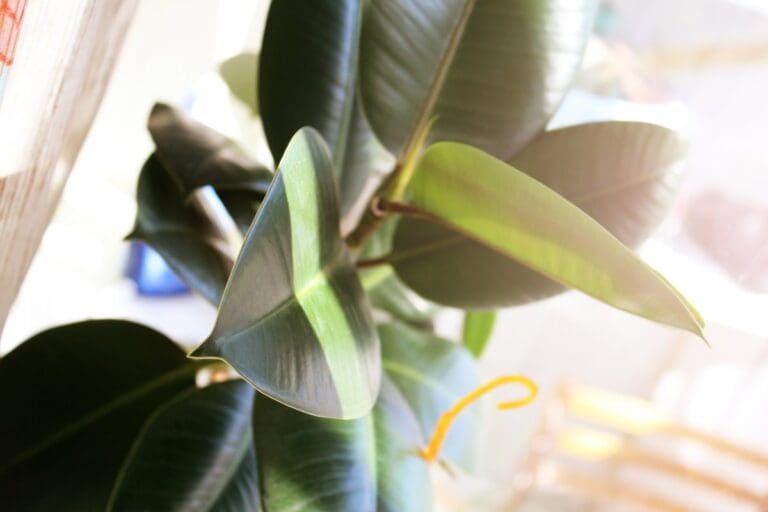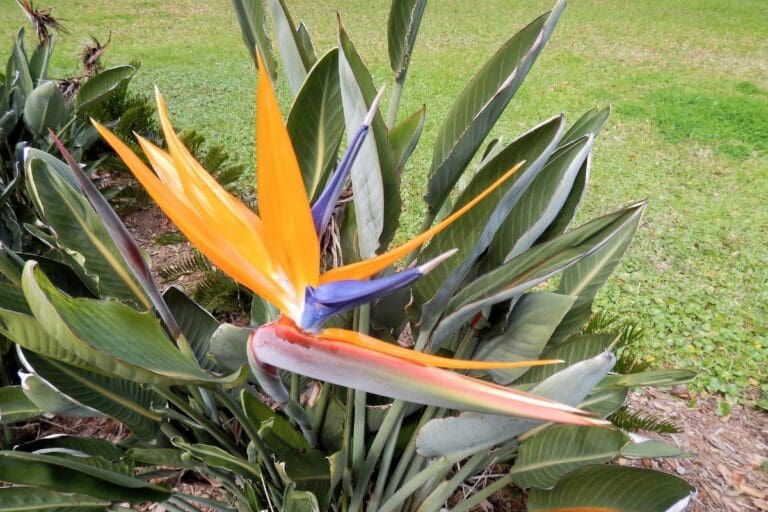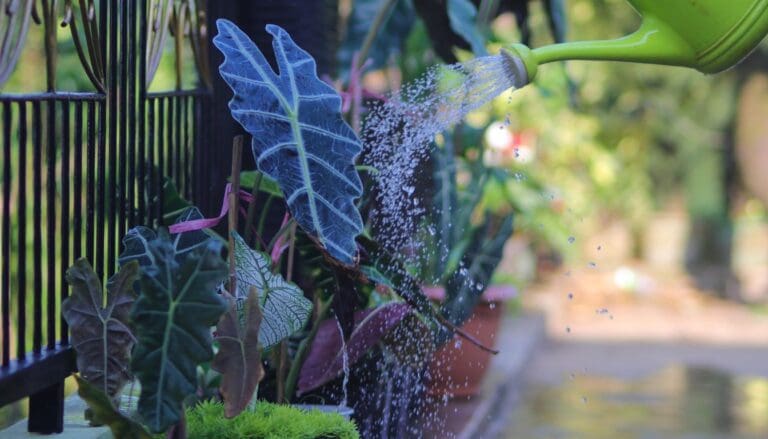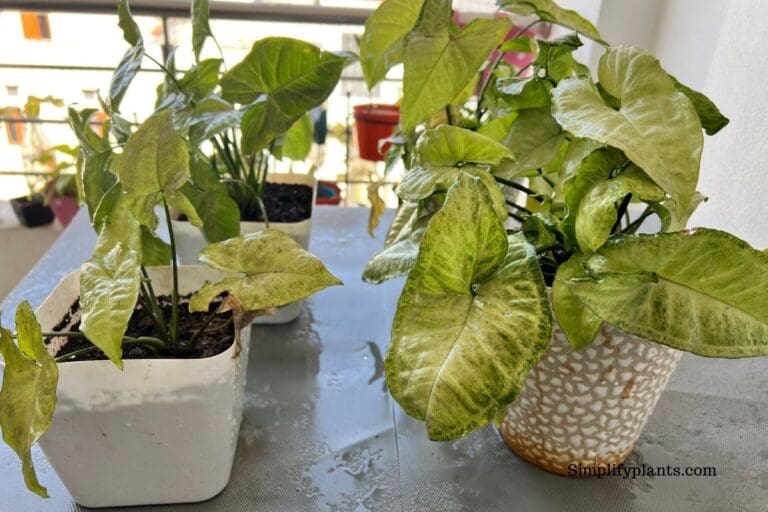Why Is My Calathea Leggy? (Possible Problems+How To Fix)
Calathea is a popular tropical houseplant with beautiful, voluminous, and dark green foliage. These plants grow around 2 feet long and grow bushier after that. But if you see it growing even longer with fewer leaves, your calathea is leggy.
A leggy Calathea plant has thin and long stems with uneven growth. But why is your calathea leggy and how can you fix the same?
The primary reason for a Calathea to turn leggy is inadequate lighting. There can also be other reasons such as wrong fertilization techniques, improper pruning, and a root-bound plant. To fix a leggy calathea plant, Move your plant to a medium-light spot and clip the leggy foliage.
Placing your calathea in a bright environment will prevent it from being leggy, but there is more to it. This article will discuss the causes that turn a Calathea plant leggy and the ways to fix it.

Please note: Simplify Plants is reader-supported. Some links in the post are affiliate links and I get a commission from purchases made through links in the post.
Why is my Calathea leggy?
Examine your Calathea for the signs of legginess. If your Calathea has uneven growth with long and slim stems that look weak, it has turned into a leggy plant.
There are various reasons why a Calathea turns leggy. Let’s read all those reasons in brief.
Inadequate light
Calatheas prefer indirect bright light. If you have placed the plant in a spot with dull light, change its location as soon as possible.
Plants need a sufficient amount of light to carry out photosynthesis. If not, it decreases the rate of photosynthesis.
A reduced rate of photosynthesis will lead to insufficient amounts of nutrients and energy to the plant. This insufficient energy will not support healthy growth, making the plant leggy.
If your calathea doesn’t get the light it needs, it will eventually grow leggier and weaker. It might even fall off the pot.
Also, keep in mind that extremely bright light can cause sunburn to the leaves of your Calathea.
Also read: How Much Light Do Calathea Plants Need? (Calathea Plant Light Requirements)
Temperature fluctuation
Temperature between 60-80°F is ideal for Calathea plants. They hail from tropical regions and can not bear cold weather.
Temperatures below 55°F or above 90°F are unsuitable for your Calathea.
The extreme fluctuations can damage the molecules of your calathea and disturb the natural processes like photosynthesis, transpiration, etc.
Fluctuating temperatures can stress the plant. It might not get accustomed to the unusual changes in its surroundings and become leggy.
So, to avoid stressing your plant, try to make the environment as comfortable as possible and maintain a proper temperature in the room.
Also read: What Temperature Can Calathea Tolerate? (Ideal Temperature Range)
Not fertilizing or fertilizing inadequately

Calathea plants receive unlimited nutrients from the soil in the wild, but as houseplants, the nutrition is restricted due to the limited medium.
The plant utilizes nutrients from that limited soil in the pot, but that soil loses that nutrition over time. Every time you water your Calathea, some nutrients drain out of the drainage holes.
If you don’t fertilize your Calathea or feed it a lot less than it needs, it will end up with no nutrients in the soil, making it leggy.
Thus, to avoid leggy Calathea plants, you should use an adequate amount of fertilizer. Fertilizers will help the plant to get nutrition and energy from external sources.
However, that doesn’t mean you can go overboard with fertilizing, as it can lead to overfertilization.
Also read:Should I Fertilize Calathea? (How Often+Best Fertilizer)
Not pruning
Many houseplant owners delay pruning, thinking that their plant might grow tall and bushy, but unfortunately, it is a myth.
Pruning in regular intervals will keep your plants in even shape.
The plant will only work on the healthy parts and in a smaller surface area.
Supplying nutrition to tall and uneven parts within that limited soil can stress the plant. And it will further lead to a leggy plant.
Moreover, pruning will also stimulate growth hormones in your plant. It will eliminate the damaged leaves, which will enhance your Calathea’s beauty.
Rootbound plant
When the roots of your Calathea grow more than its current pot can accommodate, it becomes rootbound.
If your Calathea is rootbound, it will not get enough nutrients or water as less medium will not have as many nutrients as the plant needs.
If you delay repotting your plant, it will turn leggy and weak due to insufficient nutrition.
Also read: Do Calathea Like To Be Root Bound? (+When To Repot)
How do you fix leggy Calathea?

If you have found out why your Calathea is leggy, it is time to find a solution and fix it.
Fixing a leggy plant is not that tough. But, if you keep ignoring the early signs of legginess, it will take time to fix the issue.
I had mentioned five probable causes that can make your Calathea leggy. So, now let’s find the solution to each problem.
- Provide sufficient lighting
- Maintain stable temperature
- Fertilize during summer and spring
- Prune periodically
- In the case of a rootbound calathea, repot the plant.
Now let’s discuss these and understand why these are so important for your Calathea.
Keep your Calathea where it will receive adequate light
If your Calathea doesn’t get enough light, it will become weak and leggy.
Adequate light will provide sufficient energy for the plant to perform its functions well. Calatheas need bright light for approximately 6-7 hours. But not direct sunlight.
Keep your Calathea near the window where it will receive bright light. But, restrict it from receiving direct sunlight, as it can dry out its natural moisture and cause sunburn.
Neither too bright nor too much shade is appropriate for these plants. If you think of putting your Calathea in a corner and not letting it have enough light, the plant will turn leggy.
If your house or the spot where you have kept your plant doesn’t have a good natural light source, switch to artificial lights.
Artificial lights are readily available at stores. They are convenient to use and will provide enough light to the plant.
Also, rotate your Calathea every few days. It will let the plant receive light from all angles.
Do not expose your Calathea to temperature fluctuations

Frequent fluctuations in the temperature can stress the plant. It will force your plant to utilize more energy to cope with the unusual changes. This will shock the plant and make the plant leggy.
Calatheas love humidity, so try to keep them in a humid place; you can use your bathroom in this case. People also use a humidifier to control the humidity level inside their rooms.
Temperature below 55°F is too cold for your Calathea, and it can cause damage to its beautiful leaves. The leaves will curl, and the plant might also become leggy.
Fertilize during summer and spring
Fertilizers can fulfill the lack of nutrition in the soil. But overfertilization may kill the plant, and under fertilization will make the plant leggy.
If you don’t fertilize the Calathea properly, lack of nutrition will make the plant leggy.
Never fertilize your Calathea during the winters as they rest during this season. Growing seasons are best for fertilization because the plant needs ample nutrition for new growth during that time.
Fertilizers with an NPK ratio of 10:10:10 is best for any houseplant. Nitrogen(N) encourages new growth, Potassium (K) is responsible for regulating water and nutrition in the plant, and Phosphorus(P) stimulates root growth.
Prune periodically
Frequent pruning is vital for all plants. It promotes new growth and also keeps the plant even-shaped.
Not pruning will surely increase the height of your plant, but eventually, it will turn leggy.
Steps to prune your Calathea:
First, select the area you want to prune. Better to choose branches that have brown, crisp, yellow, or damaged leaves.
Those damaged leaves are not going to recover, so better to cut them. Cutting the leaves will help the plant to focus on the growth of new leaves and branches.
It would be best also to cut those stems that are leggy and have few leaves on them. It will allow the plant to utilize energy properly.
Trim the areas with overgrowth and uneven bushy leaves; it will help airflow inside the branches.
Always use sharp scissors to ensure smooth cuts and sterile ones to avoid fungal infections.
Repot the plant

Rootbound is a severe issue if not treated early. Calatheas need repotting every 12-18 months, but you must repot it when it becomes rootbound.
A rootbound Calathea will seek extra space and will not receive sufficient water or nutrients. This will lead to a lack of nutrients, making the Calathea weak and leggy in the long run.
But you can fix this issue by repotting the plant.
To repot your Calathea, make sure that the new pot is bigger than the previous one.
Choose an appropriate potting mix that has an excellent moisture-holding capacity, as Calatheas like moist soil.
The pot should have drainage holes, and the soil should have elements that support proper drainage.
Be gentle while pulling the plant out of its old pot and transferring it into the new. Any damage can stress the plant and make it leggy.
Gently put the plant in the center, put soil on the sides to keep it upright, and water it. Then, keep the plant aside and take proper care.
Final words
Knowing your plant and its requirements is essential. Identifying the issue can help you understand the exact problem your plant is facing.
If you have a leggy Calathea and searching for causes, I have mentioned the possible causes of a leggy Calathea plant above. Identify the exact reason and try to fix it.
- Always keep your Calathea in bright light, but not direct sunlight. If it is not possible, you can use artificial lights.
- Use proper fertilizing techniques.
- Maintain the correct temperature around the room, which should be within 60-80°F and stable. Frequent changes can make the plant leggy.
- Repot the plant every one year or 18 months to keep it healthy. Check if it’s rootbound; if yes, repot immediately.
All these will prevent not only leggy growth but also fix your leggy Calathea.
Source: NCBI, University of Florida, Wikipedia, Growing Indoor Plants with Success, Agriculture, and Natural Resources, University of California, Missouri Botanical Garden.
Recommended Garden Supplies
| Product Image | Our Recommended Gardening Supplies | Check Offers! |
|---|---|---|
Top Top
Top
Top
Top
Top
Top
Top
Top | rePotme Houseplant and Tropical Classic Potting Soil Mix | Check Offer On Amazon |
 Top
Top
Top
Top
Top
Top
Top
Top | Espoma Organic Indoor Plant Food | Check Offer On Amazon |
 Top
Top
Top
Top
Top
Top
Top
Top | GooingTop LED Grow Light 6000K Full Spectrum Clip Plant Growing Lamp | Check Offer On Amazon |
 Top
Top
Top
Top
Top
Top
Top
Top | Soil Moisture Meter | Check Offer On Amazon |
 Top
Top
Top
Top
Top
Top
Top
Top | Govee Hygrometer Thermometer, Bluetooth Enabled! | Check Offer On Amazon |
 Top
Top | LEVOIT Humidifiers for Large Room(Best For Plants) | Check Offer On Amazon |
 Top
Top
Top
Top
Top
Top
Top
Top | Upgraded DIY Automatic Drip Irrigation Kit, 15 Potted Houseplants Support | Check Offer On Amazon |
 Top
Top
Top
Top
Top
Top
Top
Top | Stainless Steel Heavy Duty Gardening Tool Set | Check Offer On Amazon |
 Top
Top
Top
Top
Top
Top
Top
Top | Bonide Insecticidal Soap | Check Offer On Amazon |
 Top
Top
Top
Top
Top
Top
Top
Top | Bonide 32 oz Spray Neem Oil for Organic Gardening | Check Offer On Amazon |
 Top
Top
Top
Top
Top
Top
Top
Top | Garden Safe Fungicide | Check Offer On Amazon |






